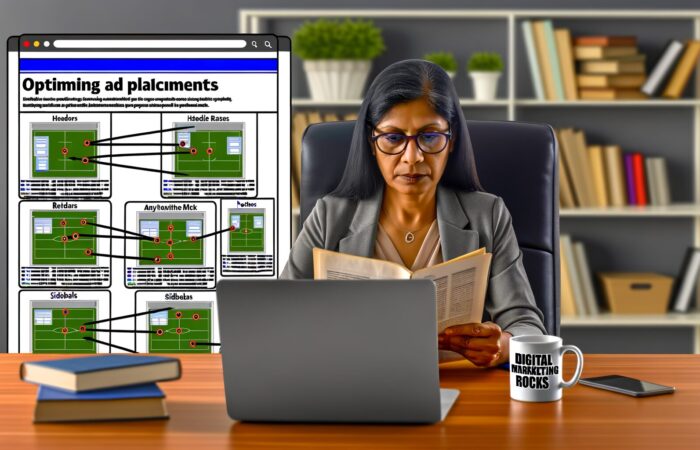Click-through rate is the percentage of users who click on an advertisement compared to the total number of users who view the ad. This metric is pivotal in determining the effectiveness of your ad campaigns and in optimizing your advertising budget.
1. Identifying High-Performing Ad Positions
Finding the optimal ad placement is crucial to yield the best results.
Above-the-Fold vs. Below-the-Fold
Above-the-fold areas, the section of the web page visible without scrolling, conventionally see higher CTRs. However, relevance and content alignment are also pivotal, making a below-the-fold placement potentially effective in the right context.
Header, Sidebar, and In-Content Ads
Ads in the header and sidebar tend to have excellent visibility. However, in-content ads generally integrate better with user behavior, often resulting in higher interaction rates.
Mobile vs. Desktop Placement
Understanding the primary device used by your audience can guide optimal ad placement. Mobile users might engage more with vertically placed in-content ads, while desktop users might respond better to horizontal placements.
2. Leveraging User Behavior Analytics
User behavior analytics provide insights into how users interact with your site.
Heatmaps and Scroll Maps
These tools help visualize engagement, highlighting where users click, hover, or scroll the most. Heatmaps reveal hotspots of action, guiding you to place ads in those high-engagement zones.
Session Recording Tools
Session recordings offer a playback of user interactions, helping understand click patterns and improving ad placements as evidence-based strategy.
Identifying User Interaction Patterns
By studying how users navigate your site, their click paths, and areas of attention, you can place ads where users naturally pay attention, increasing engagement and CTR.
3. A/B Testing for Optimal Ad Placement
A/B testing is an essential methodology to test different ad placements and formats.
Setting Up A/B Tests
Create variations with single changes to compare effectively – one might test different locations, ad styles, or even ad sizes.
Metrics to Monitor
Track key metrics such as CTR, conversion rate, bounce rate, and overall user engagement.
Analyzing Test Results
Using emerging data, you can confidently decide on the most effective ad placement configurations.
4. Tailoring Ad Placement Based on Content Type
Different types of content may benefit from varied ad placement strategies.
Blog Posts and Articles
In-content ads placed strategically within posts can integrate smoothly and capture user interest without interrupting the reading flow.
E-commerce Websites
Ads on product pages and close to calls to action can enhance visibility without overshadowing your products.
Multimedia Content
Overlay ads in videos or images placed contextually can capture attention without becoming intrusive.
5. Utilizing Programmatic Advertising
Programmatic advertising automates the buying and selling of ads in real time.
Real-Time Bidding (RTB) Explained
RTB involves buying and selling online ad impressions through real-time auctions, optimizing ad spend with precise targeting.
Benefits of Programmatic Ad Placement
The automation and targeting accuracy reduce wasteful ad spend while maximizing CTR by reaching highly relevant audience segments.
Tools and Platforms
Leveraging tools like Google’s Display & Video 360 or Amazon DSP can simplify your programmatic ad strategies (Read more on programmatic benefits).
6. Enhancing User Experience
Striking the right balance between content and ads is essential.
Avoiding Intrusive Ads
Non-intrusive, contextually relevant ads engage users better without disrupting their experience.
Balancing Content and Advertising
Ensuring sufficient space for usable content and strategically dispersed ads can elevate user engagement and satisfaction.
Maintaining Site Speed and Performance
A well-functioning, fast website retains users, indirectly boosting ad CTR. Check Google’s PageSpeed Insights to ensure optimal performance.
7. Ad Formats and Their Impact on CTR
Different ad formats can affect CTR remarkably.
Display Ads
Long-established, visually appealing display ads are widely used across varying site types.
Native Ads
Seamlessly intertwined with the surrounding content, native ads can provide a high-quality interaction devoid of user disruption.
Video Ads
Highly engaging and versatile, video ads can impressively narrate a brand message while urging users to click through.
8. Monitoring and Refining Ad Performance
Consistently measuring and iterating on your strategies is key.
Regular Performance Audits
Frequent audits ensure constant optimization, revealing elements in need of improvement.
Adjusting Strategies Based on Data
Deep-dive into algorithm-driven insights, adopting adaptable strategies that continue to align with current findings.
Keeping Up with Industry Trends
Understanding trends within the advertisement ecosystem encourages relevance and innovative approaches (Learn about new trends).
9. Case Studies of Successful Ad Placement
Real-world success highlights valuable lessons in ad optimization.
Real-World Examples
Companies like Google and Facebook continuously evolve their ad strategies, offering rich case studies highlighting top-tier placements for different industries.
Key Takeaways
Select inspiring strategies, note observable ideas, and integrate learning for scalable gains.
Lessons Learned
Ongoing experimentation and strategic planning based on comprehensive datasets will position your ad placements ahead of the curve.










No Comment! Be the first one.